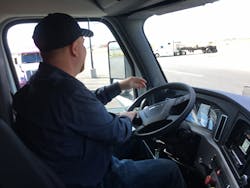Congress is being encouraged by a significant number of trucking industry associations and also folks involved in things like food distribution to back a bill that would create a way for people between the ages of 18 and 21 to become truck drivers who could operate in interstate commerce.
The legislation—the Developing Responsible Individuals for a Vibrant Economy Act, a.k.a. DRIVE-Safe Act—outlines a plan for a rigorous program to develop skills and provide safety training for these younger drivers. Currently, many states allow drivers 18-21 years old to get CDLs, but limit them to driving only in intrastate commerce.
The depth of the driver shortage is slowing down commerce, and this proposal is an effort to widen the driver pool.
If the bill passes, we will have a unique opportunity to try to attract people to trucking. I think we can use some of the technology that helps with fuel-efficient operation to attract these young people. Since the younger generation grew up on technology, they expect to use it on their jobs.
But they probably don't know about all the cool stuff on trucks, like the ability to set electronic engine parameters, all the sensors on a truck that are constantly monitoring the way the truck is operating, or the data that can be collected about how the driver is performing.
I also think that if we can get these younger drivers we should include fuel efficiency training in the curriculum—or at the very least get these young drivers started on the right foot by spending time with them explaining the impact that idling has on fuel economy, talking with them about things like time in top gear and time in cruise, etc. Right from the start, these new drivers would develop good driving habits as they relate to fuel economy and we wouldn't have to first overcome ingrained bad driving habits in order to get them to keep fuel economy in mind as they drive. And it wouldn't hurt if these new drivers were given incentives when they hit fuel economy goals.
I bet some of our superstar drivers, like the ones who participated in Run on Less, would love to share their techniques for consistently achieving 10+ mpg. The drivers who participated are passionate about fuel economy, and I am guessing they all want to see more drivers jump on the fuel efficiency bandwagon. I think drivers who are committed to fuel efficiency can help the rookies learn how what they do can impact fuel efficiency positively or negatively.
Given all the cool technology on trucks, I think if the legislation passes we have a golden opportunity to get more young people into our industry and train them right—right from the very beginning.
About the Author

Michael Roeth
Executive Director
Michael Roeth is the executive director of the North American Council for Freight Efficiency. He serves on the second National Academy of Sciences Committee on Technologies and Approaches for Reducing the Fuel Consumption of Medium and Heavy-Duty Vehicles and has held various positions with Navistar and Behr/Cummins.
